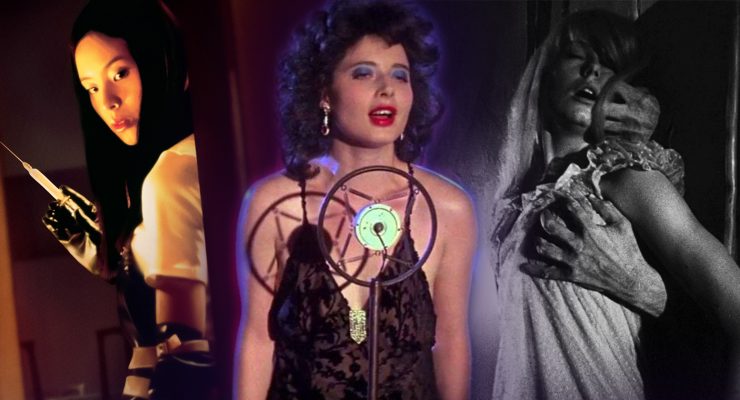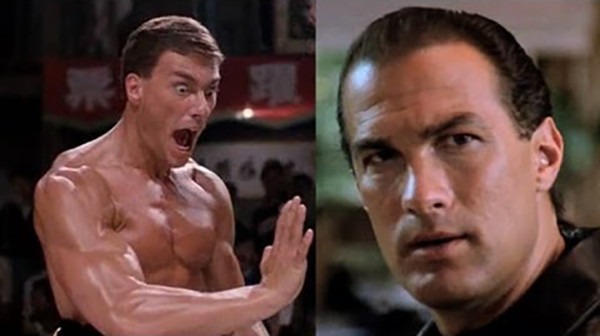Last spring, it was announced that Cinedigm would be adding another horror title to their ever-expanding genre roster, Peter ‘Drago’ Tiemann’s festival favorite The Stairs. The wait is finally over, as the film is now available on demand and digital. What started as a week’s long adventure with friends, quickly turns into a terrifying fight for survival in The Stairs. In 1997, a young boy is out hunting with his grandfather (Schneider), when he stumbles upon a mysterious staircase deep in the forest. The subsequent disappearance leaves locals baffled as to the fate of the wayward pair. Twenty years later, a group of hikers set off on an ambitious trail, deep into the same stretch of wilderness where they stumble upon the same set of ominous stairs. Descending deep below the earth, they find themselves coming face to face with the thing that nightmares are made of. There are many things that stick out about The Stairs, one of them being the cinematography by Ryan Purcell, which has been recognized at numerous festivals. To learn more about Purcell’s creative process on the film, we conducted the exclusive Q & A with him.
You have worked with director Peter ‘Drago’ Tiemann on a few projects before The Stairs. Because you already had an existing relationship with him, did you have a little more freedom to experiment?
I’m not sure “freedom to experiment” is exactly the right phrase. I think that, because of our prior relationship, we had a level of trust from the very beginning. If we were to hit a rough patch, we knew we would be able to figure it out together. So it just let us hit the ground running right from the get go.
Based on the trailer, it looks like you all used a handheld camera for some of the scenes in the woods. Is that true? How did you decide when to use a handheld verse Steadicam?
It was a mix of everything really. Handheld, steady, dana dolly. Daniel Mimura, our Steadycam op, was with us for the entire film, which was somewhat of a luxury on our budget. He did a great job. Sometimes we used the Steadycam for hiking “walk and talks” but it was really useful when we were trying to set up a feeling of tension. A good example is the sweeping Steadycam shot we used to introduce the big “nest.” The reveal really lands. The biggest problem on a 360-degree shot like that is keeping the shot clean of your own people. We finally managed to hide everyone behind the nest itself but it was no easy task. Once video village is set up it gains some gravity or something and it just gets hard to move. We would usually go handheld when things went south, just to add a little more energy and a little more smear and jitter to the image. If there was a monster in the shot – or if they were being chased by a monster – then it was probably handheld.
Was there a time on The Stairs when you had to get really creative with the way something was shot or lit because of budgetary constraints?
One shot that stands out in my mind was when Dirty Doug gets eaten by the Grub Daddy. It was the last shot of the night, and for some reason this shot was a bit of an afterthought probably because we had been shooting a fairly complicated sequence prior to this that had sucked up all our brain power. We didn’t even know exactly where we were going to shoot this epic night shot. And we had about 20 minutes to get it. So with that kind of a time frame I knew I was not going to be able to move a lot of pieces around – which actually really simplified things. I knew where my edge lights were, and I knew where my campfire light was, and where the smoke line had been placed. I also knew I needed to hide video village and all the gear from our previous set ups. We ended up staging the scene on a pile of giant logs, which allowed us to use all the lighting pieces that were already in place and which had the benefit of raising the action up off the ground and making everything more visible to the camera which is handy in an evisceration scene. The pile of logs also hid all our equipment. It worked out great. I was a little torn in my framing at first because I felt I wanted to see the action up close in a wide frame and I was also maybe worried about hiding all our stuff. I started thinking “this is your epic wide shot?” and eventually I tucked back deep in the woods, got about as wide as I could, and the shot ended up being one of my favorites in the movie.
Obviously, the actual staircase plays a significant part in the film. Was more emphasis put on this location than others, to get just right?
The staircase actually exists in two locations. It’s a little hard to tell because the first time we see the stairs it is in broad daylight and the second time it is at night. The art department, lead by Peter Spawn, actually moved the stairs from its day location to its night location. Then once it was re-built they had to move it again! The Fire Department came by and said that it was built too close to the woods and would not allow us to burn it. So the art department moved it 15 feet further out into the clearing, away from the trees in the back. (That actually worked out better for the film but I’m glad I didn’t have to ask them to move it.) It was quite a job lifting it and moving it, and it had to be done with a pre-call because we were shooting it that day. It does look beautiful when it goes up in flames.
Is there a scene in the film that you are particularly proud of, that you would like to direct audiences to especially pay attention to?
I like the “agitated man” scene and the way it builds throughout – although we did have a one’er steadycam intro to the scene that they ended up cutting into for pacing reasons. I would have liked to see how the one’er played. But there’s no sense in second guessing editors! They are in it deep. Michael Tang, the editor on The Stairs, cuts a whip pan into this scene that perfectly disrupts things at a pivotal moment and really takes it to another level. A successful whip pan is a rare bird indeed. So it might be worth watching it for that element alone!
What would you say is your signature style as a cinematographer? Is there a specific genre that you really shine at?
I feel like I have some range. I would say my work is well suited for horror/thriller films, but really for most dramas – any film where you might be looking for a little extra pizzaz in the lighting or camerawork. Overall I like to keep the camera moving and connect as many dots as I can with my shots and keep the performances flowing. I try to keep the story at the forefront of my mind. What’s the sense of a beautiful shot (or scene) if it works against the story you are trying to tell? If the scene is bleak, how can you make it more bleak? If romantic how can it be more so? And on and on. How can you heighten whatever it is that you’re trying to put across or make it clearer to the audience. I worked as a grip on Fire Walk With Me and have a very clear memory of having spent most of a day pre-lighting a big night exterior in the woods where the villain with evil intentions drags these two girls down this path. And David Lynch comes onto set and starts waving his hands around and saying “No, No! This is all wrong!” So they turned off all the lights we had spent all day rigging, and lit the scene with a few flashlights and bounce cards. And it’s a great terrifying scene. That’s maybe a little off topic but it’s a memory that has stuck with me. I don’t want to make a huge effort on something that is just not right for the film.
In your bio you mention that you worked with Academy Award winner Haskel Wexler. Can you talk about what projects you worked with him on and what he taught you?
I worked with Haskel Wexler on a film called The Rich Man’s Wife. I was lucky to be working as a grip in Seattle in the 90’s when a lot of really great DP’s came through town. I like being on set and watching what is going on, and finding various ways to be useful. One time he was lighting a night exterior and I was watching him and trying to see it through his eyes. So I asked him if he wanted me to cut some blue moonlight off of this house. I thought that was what he might have been thinking about. He turned to me – maybe a little glint in his eye – and said “I don’t know. What do you think?” Well, I was smart enough to say “looks pretty good to me.” And he said “Let’s leave it then.” So I learned kindness from him, that’s for sure! Or maybe tolerance. And I have to say that when he and his Key Grip came back to town on a different gig, they did call me, so I guess he didn’t hold it against me.
Is there another specific showrunner or director you would love the opportunity to work with?
Boy, that’s a tough question. I’m based in Seattle so I’m a little out of the loop! I’m always looking for interesting narrative projects to take on and like-minded people to take them on with. I have traveled a fair amount to a variety of locations for work, sometimes to exotic locations like Tanzania and Indonesia and sometimes to exotic locations like… Detroit. I like some variety I guess.
What are you working on next?
I’m currently in the middle of shooting a documentary on Mike Mignola, the creator of Hellboy. An interview with Guillermo del Toro is in the works, which is pretty exciting. I’ve always loved his films. I’m also attached to a film called This Bloody Country that is planning on shooting this fall. It’s a western and I’ve never shot a western before. We head to Utah to scout next week.
Many thanks to Ryan Purcell for taking the time for this interview. Read more about Ryan here.












